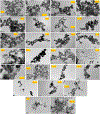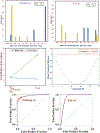Evaluating the cytotoxicity of a large pool of metal oxide nanoparticles to Escherichia coli: Mechanistic understanding through In Vitro and In Silico studies
- PMID: 33022504
- PMCID: PMC7919734
- DOI: 10.1016/j.chemosphere.2020.128428
Evaluating the cytotoxicity of a large pool of metal oxide nanoparticles to Escherichia coli: Mechanistic understanding through In Vitro and In Silico studies
Abstract
The toxic effect of eight metal oxide nanoparticles (MONPs) on Escherichia coli was experimentally evaluated following standard bioassay protocols. The obtained cytotoxicity ranking of these studied MONPs is Er2O3, Gd2O3, CeO2, Co2O3, Mn2O3, Co3O4, Fe3O4/WO3 (in descending order). The computed EC50 values from experimental data suggested that Er2O3 and Gd2O3 were the most acutely toxic MONPs to E. coli. To identify the mechanism of toxicity of these 8 MONPs along with 17 other MONPs from our previous study, we employed seven classifications and machine learning (ML) algorithms including linear discriminant analysis (LDA), naïve bayes (NB), multinomial logistic regression (MLogitR), sequential minimal optimization (SMO), AdaBoost, J48, and random forest (RF). We also employed 1st and 2nd generation periodic table descriptors developed by us (without any sophisticated computing facilities) along with experimentally analyzed Zeta-potential, to model the cytotoxicity of these MONPs. Based on qualitative validation metrics, the LDA model appeared to be the best among the 7 tested models. The core environment of metal defined by the ratio of the number of core electrons to the number of valence electrons and the electronegativity count of oxygen showed a positive impact on toxicity. The identified properties were important for understanding the mechanisms of nanotoxicity and for predicting the potential environmental risk associated with MONPs exposure. The developed models can be utilized for environmental risk assessment of any untested MONP to E. coli, thereby providing a scientific basis for the design and preparation of safe nanomaterials.
Keywords: Classification; In silico; In vitro; Machine learning; Metal oxide; Nanoparticles; Toxicity.
Copyright © 2020 Elsevier Ltd. All rights reserved.
Conflict of interest statement
Declaration of competing interest The authors declare that they have no known competing financial interests or personal relationships that could have appeared to influence the work reported in this paper.
Figures



Similar articles
-
In vitro and in silico study of mixtures cytotoxicity of metal oxide nanoparticles to Escherichia coli: a mechanistic approach.Nanotoxicology. 2022 Jun;16(5):566-579. doi: 10.1080/17435390.2022.2123750. Epub 2022 Sep 23. Nanotoxicology. 2022. PMID: 36149909 Free PMC article.
-
Modeling and mechanistic understanding of cytotoxicity of metal oxide nanoparticles (MeOxNPs) to Escherichia coli: categorization and data gap filling for untested metal oxides.Nanotoxicology. 2022 Mar;16(2):152-164. doi: 10.1080/17435390.2022.2038299. Epub 2022 Feb 15. Nanotoxicology. 2022. PMID: 35166631
-
Periodic table-based descriptors to encode cytotoxicity profile of metal oxide nanoparticles: a mechanistic QSTR approach.Ecotoxicol Environ Saf. 2014 Sep;107:162-9. doi: 10.1016/j.ecoenv.2014.05.026. Epub 2014 Jun 18. Ecotoxicol Environ Saf. 2014. PMID: 24949897
-
The nanotechnology among US: are metal and metal oxides nanoparticles a nano or mega risk for soil microbial communities?Crit Rev Biotechnol. 2019 Mar;39(2):157-172. doi: 10.1080/07388551.2018.1523865. Epub 2018 Nov 5. Crit Rev Biotechnol. 2019. PMID: 30396282 Review.
-
Nano-QSAR modeling for predicting the cytotoxicity of metallic and metal oxide nanoparticles: A review.Ecotoxicol Environ Saf. 2022 Sep 15;243:113955. doi: 10.1016/j.ecoenv.2022.113955. Epub 2022 Aug 9. Ecotoxicol Environ Saf. 2022. PMID: 35961199 Review.
Cited by
-
Iron Overload in Brain: Transport Mismatches, Microbleeding Events, and How Nanochelating Therapies May Counteract Their Effects.Int J Mol Sci. 2024 Feb 16;25(4):2337. doi: 10.3390/ijms25042337. Int J Mol Sci. 2024. PMID: 38397013 Free PMC article. Review.
-
Application of Computing as a High-Practicability and -Efficiency Auxiliary Tool in Nanodrugs Discovery.Pharmaceutics. 2023 Mar 25;15(4):1064. doi: 10.3390/pharmaceutics15041064. Pharmaceutics. 2023. PMID: 37111551 Free PMC article. Review.
-
Prediction of Dynamic Toxicity of Nanoparticles Using Machine Learning.Toxics. 2024 Oct 15;12(10):750. doi: 10.3390/toxics12100750. Toxics. 2024. PMID: 39453170 Free PMC article.
-
Machine Learning for Evaluating the Cytotoxicity of Mixtures of Nano-TiO2 and Heavy Metals: QSAR Model Apply Random Forest Algorithm after Clustering Analysis.Molecules. 2022 Sep 19;27(18):6125. doi: 10.3390/molecules27186125. Molecules. 2022. PMID: 36144857 Free PMC article.
-
Metal/metal oxide nanoparticles: Toxicity concerns associated with their physical state and remediation for biomedical applications.Toxicol Rep. 2021 Nov 30;8:1970-1978. doi: 10.1016/j.toxrep.2021.11.020. eCollection 2021. Toxicol Rep. 2021. PMID: 34934635 Free PMC article. Review.
References
-
- Aruoja V, Pokhrel S, Sihtmäe M, Mortimer M, Mädler L, Kahru A, 2015. Toxicity of 12 metal-based nanoparticles to algae, bacteria and protozoa. Environ. Sci.: Nano 2, 630–644.
-
- Arvidsson R, Baun A, Furberg A, Hansen SF, Molander S, 2018. Proxy measures for simplified environmental assessment of manufactured nanomaterials. Environ. Sci. Technol. 52, 13670–13680. - PubMed
-
- Bartlett PL, Traskin M, 2007. AdaBoost is consistent. J. Mach. Learn. Res 8, 2347–2368.
-
- Basant N, Gupta S, 2017a. Modeling uptake of nanoparticles in multiple human cells using structure-activity relationships and intercellular uptake correlations. Nanotoxicology 11, 20–30. - PubMed
-
- Basant N, Gupta S, 2017b. Multi-target QSTR modeling for simultaneous prediction of multiple toxicity endpoints of nano-metal oxides. Nanotoxicology 11, 339–350. - PubMed
MeSH terms
Substances
Grants and funding
LinkOut - more resources
Full Text Sources
Other Literature Sources
Miscellaneous

